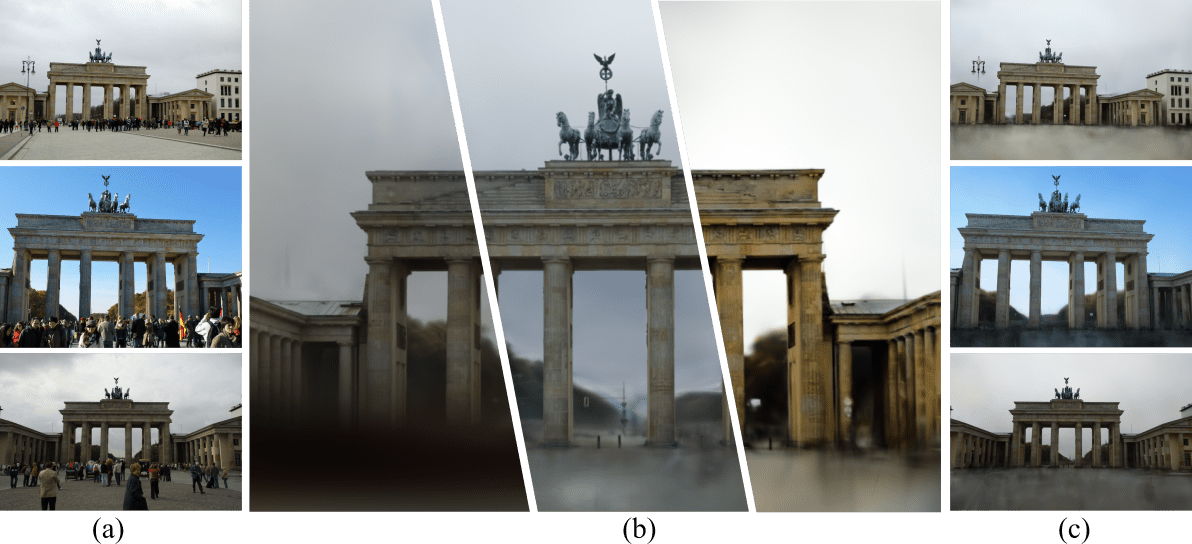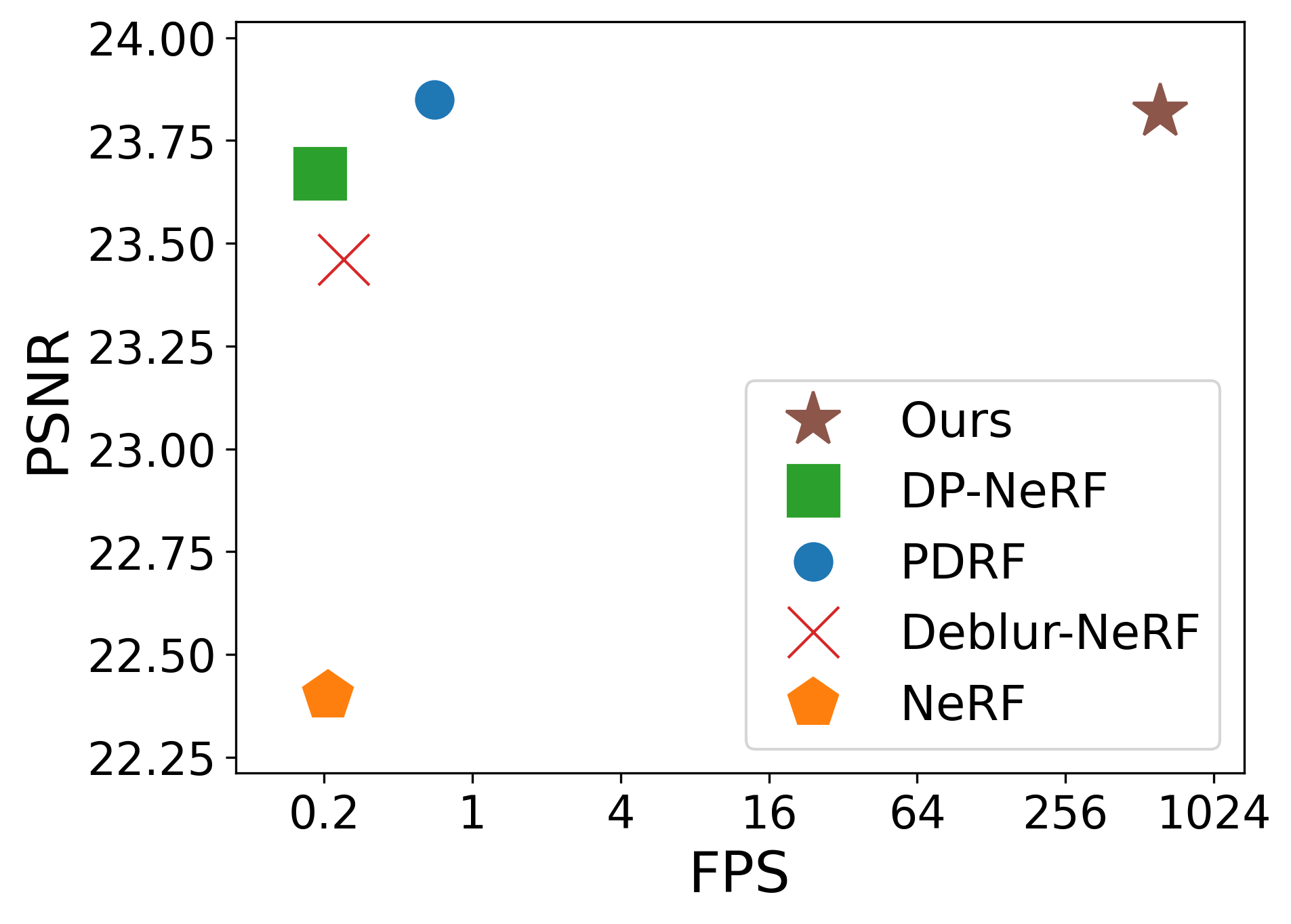3D Gaussian Splatting as Markov Chain Monte Carlo
2404.09591

0
0

Abstract
While 3D Gaussian Splatting has recently become popular for neural rendering, current methods rely on carefully engineered cloning and splitting strategies for placing Gaussians, which can lead to poor-quality renderings, and reliance on a good initialization. In this work, we rethink the set of 3D Gaussians as a random sample drawn from an underlying probability distribution describing the physical representation of the scene-in other words, Markov Chain Monte Carlo (MCMC) samples. Under this view, we show that the 3D Gaussian updates can be converted as Stochastic Gradient Langevin Dynamics (SGLD) updates by simply introducing noise. We then rewrite the densification and pruning strategies in 3D Gaussian Splatting as simply a deterministic state transition of MCMC samples, removing these heuristics from the framework. To do so, we revise the 'cloning' of Gaussians into a relocalization scheme that approximately preserves sample probability. To encourage efficient use of Gaussians, we introduce a regularizer that promotes the removal of unused Gaussians. On various standard evaluation scenes, we show that our method provides improved rendering quality, easy control over the number of Gaussians, and robustness to initialization.
Create account to get full access
Overview
- This paper proposes a novel 3D Gaussian splatting technique as a Markov Chain Monte Carlo (MCMC) method for efficient novel-view synthesis.
- The method leverages the properties of Gaussian distributions to represent 3D points and efficiently render novel views.
- The paper explores the connections between Gaussian splatting and MCMC, demonstrating the effectiveness of this approach for tasks like novel-view synthesis via Neural Radiance Fields, 3D reconstruction, and SLAM.
Plain English Explanation
The paper introduces a new way to generate 3D scenes from a set of input images. It uses a technique called "Gaussian splatting" to efficiently represent and render the 3D points in the scene. Gaussian splatting treats each 3D point as a Gaussian distribution, which can be thought of as a bell-shaped curve centered on that point.
This Gaussian representation allows the method to quickly calculate how much each point contributes to the final image, without having to do a lot of complex calculations. The paper shows that this Gaussian splatting approach is a type of Markov Chain Monte Carlo (MCMC) algorithm, which is a powerful statistical technique for sampling and generating new data.
By combining Gaussian splatting with MCMC, the method can generate high-quality novel views of the 3D scene from just a few input images. This makes it useful for applications like novel-view synthesis, 3D reconstruction, and SLAM. The key innovation is using the Gaussian representation to make the rendering much more efficient, while still maintaining high-quality results.
Technical Explanation
The paper presents a 3D Gaussian splatting technique as a Markov Chain Monte Carlo (MCMC) method for efficient novel-view synthesis. The core idea is to represent 3D points as Gaussian distributions and leverage the properties of Gaussians to enable fast and accurate rendering of novel views.
The authors show that 3D Gaussian splatting can be formulated as a MCMC sampling process, where the Gaussian distributions are treated as probability distributions that are iteratively sampled to generate the final image. This connection to MCMC provides a principled statistical framework for the approach and allows the authors to draw insights from the vast literature on MCMC methods.
Experiments demonstrate the effectiveness of the 3D Gaussian splatting MCMC approach for tasks such as novel-view synthesis, 3D reconstruction, and SLAM. The method is shown to outperform existing techniques in terms of rendering quality and efficiency, making it a promising direction for further research and development.
Critical Analysis
The paper provides a compelling technical contribution by formulating 3D Gaussian splatting as a MCMC sampling process. This connection to MCMC theory is insightful and opens up new avenues for further research and optimization of the approach.
However, the paper does not address certain limitations of the Gaussian splatting representation. For example, Gaussians may not be the best choice for modeling complex, non-Gaussian 3D geometry, and the method may struggle with scenes containing sharp edges or discontinuities. Additionally, the paper does not provide a thorough analysis of the computational complexity and runtime performance of the proposed MCMC algorithm, which would be crucial for real-world applications.
Further research could explore alternative splatting representations or hybrid approaches that combine Gaussian splatting with other rendering techniques to address these limitations. A more detailed comparative evaluation against state-of-the-art methods would also help contextualize the strengths and weaknesses of the proposed approach.
Conclusion
This paper presents a novel 3D Gaussian splatting technique as a Markov Chain Monte Carlo (MCMC) method for efficient novel-view synthesis. By representing 3D points as Gaussian distributions and leveraging the properties of Gaussians, the method can generate high-quality novel views from a few input images in a computationally efficient manner.
The key innovation is the connection between Gaussian splatting and MCMC, which provides a principled statistical framework for the approach and allows it to be applied to a variety of 3D vision tasks, such as novel-view synthesis, 3D reconstruction, and SLAM. While the method shows promise, further research is needed to address its limitations and explore hybrid approaches that can handle more complex 3D geometries and scenes.
This summary was produced with help from an AI and may contain inaccuracies - check out the links to read the original source documents!
Related Papers

SWAG: Splatting in the Wild images with Appearance-conditioned Gaussians
Hiba Dahmani, Moussab Bennehar, Nathan Piasco, Luis Roldao, Dzmitry Tsishkou

0
0
Implicit neural representation methods have shown impressive advancements in learning 3D scenes from unstructured in-the-wild photo collections but are still limited by the large computational cost of volumetric rendering. More recently, 3D Gaussian Splatting emerged as a much faster alternative with superior rendering quality and training efficiency, especially for small-scale and object-centric scenarios. Nevertheless, this technique suffers from poor performance on unstructured in-the-wild data. To tackle this, we extend over 3D Gaussian Splatting to handle unstructured image collections. We achieve this by modeling appearance to seize photometric variations in the rendered images. Additionally, we introduce a new mechanism to train transient Gaussians to handle the presence of scene occluders in an unsupervised manner. Experiments on diverse photo collection scenes and multi-pass acquisition of outdoor landmarks show the effectiveness of our method over prior works achieving state-of-the-art results with improved efficiency.
4/8/2024

Recent Advances in 3D Gaussian Splatting
Tong Wu, Yu-Jie Yuan, Ling-Xiao Zhang, Jie Yang, Yan-Pei Cao, Ling-Qi Yan, Lin Gao

0
0
The emergence of 3D Gaussian Splatting (3DGS) has greatly accelerated the rendering speed of novel view synthesis. Unlike neural implicit representations like Neural Radiance Fields (NeRF) that represent a 3D scene with position and viewpoint-conditioned neural networks, 3D Gaussian Splatting utilizes a set of Gaussian ellipsoids to model the scene so that efficient rendering can be accomplished by rasterizing Gaussian ellipsoids into images. Apart from the fast rendering speed, the explicit representation of 3D Gaussian Splatting facilitates editing tasks like dynamic reconstruction, geometry editing, and physical simulation. Considering the rapid change and growing number of works in this field, we present a literature review of recent 3D Gaussian Splatting methods, which can be roughly classified into 3D reconstruction, 3D editing, and other downstream applications by functionality. Traditional point-based rendering methods and the rendering formulation of 3D Gaussian Splatting are also illustrated for a better understanding of this technique. This survey aims to help beginners get into this field quickly and provide experienced researchers with a comprehensive overview, which can stimulate the future development of the 3D Gaussian Splatting representation.
4/16/2024

Bootstrap 3D Reconstructed Scenes from 3D Gaussian Splatting
Yifei Gao, Jie Ou, Lei Wang, Jun Cheng

0
0
Recent developments in neural rendering techniques have greatly enhanced the rendering of photo-realistic 3D scenes across both academic and commercial fields. The latest method, known as 3D Gaussian Splatting (3D-GS), has set new benchmarks for rendering quality and speed. Nevertheless, the limitations of 3D-GS become pronounced in synthesizing new viewpoints, especially for views that greatly deviate from those seen during training. Additionally, issues such as dilation and aliasing arise when zooming in or out. These challenges can all be traced back to a single underlying issue: insufficient sampling. In our paper, we present a bootstrapping method that significantly addresses this problem. This approach employs a diffusion model to enhance the rendering of novel views using trained 3D-GS, thereby streamlining the training process. Our results indicate that bootstrapping effectively reduces artifacts, as well as clear enhancements on the evaluation metrics. Furthermore, we show that our method is versatile and can be easily integrated, allowing various 3D reconstruction projects to benefit from our approach.
5/14/2024

Deblurring 3D Gaussian Splatting
Byeonghyeon Lee, Howoong Lee, Xiangyu Sun, Usman Ali, Eunbyung Park

0
0
Recent studies in Radiance Fields have paved the robust way for novel view synthesis with their photorealistic rendering quality. Nevertheless, they usually employ neural networks and volumetric rendering, which are costly to train and impede their broad use in various real-time applications due to the lengthy rendering time. Lately 3D Gaussians splatting-based approach has been proposed to model the 3D scene, and it achieves remarkable visual quality while rendering the images in real-time. However, it suffers from severe degradation in the rendering quality if the training images are blurry. Blurriness commonly occurs due to the lens defocusing, object motion, and camera shake, and it inevitably intervenes in clean image acquisition. Several previous studies have attempted to render clean and sharp images from blurry input images using neural fields. The majority of those works, however, are designed only for volumetric rendering-based neural radiance fields and are not straightforwardly applicable to rasterization-based 3D Gaussian splatting methods. Thus, we propose a novel real-time deblurring framework, Deblurring 3D Gaussian Splatting, using a small Multi-Layer Perceptron (MLP) that manipulates the covariance of each 3D Gaussian to model the scene blurriness. While Deblurring 3D Gaussian Splatting can still enjoy real-time rendering, it can reconstruct fine and sharp details from blurry images. A variety of experiments have been conducted on the benchmark, and the results have revealed the effectiveness of our approach for deblurring. Qualitative results are available at https://benhenryl.github.io/Deblurring-3D-Gaussian-Splatting/
5/28/2024